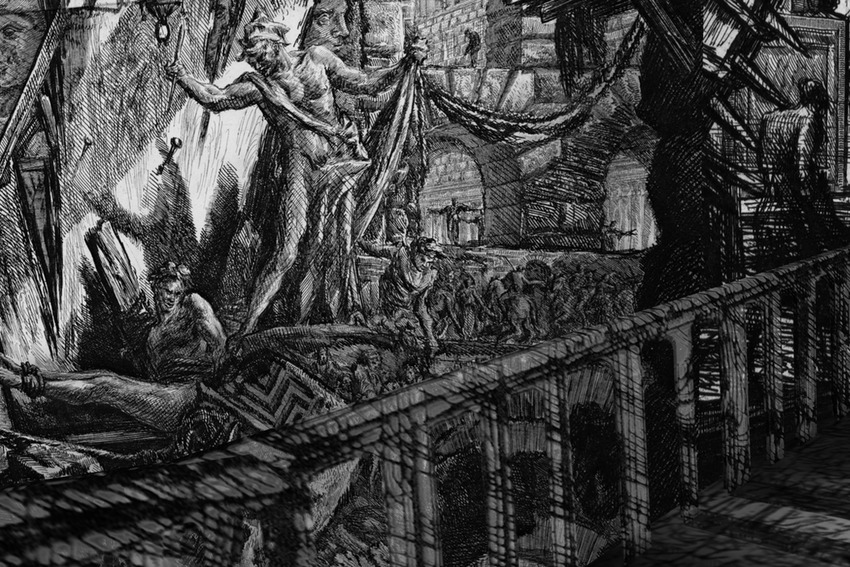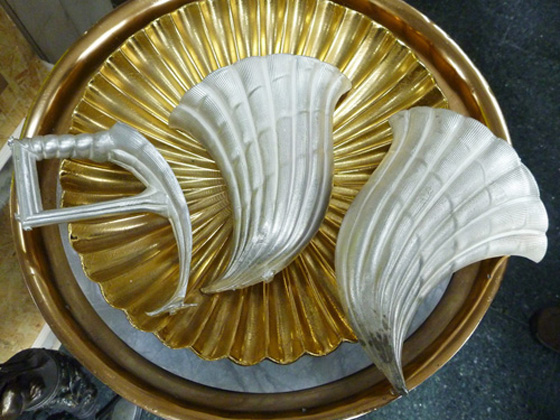
However, Piranesi did not limit himself to simply recording and replicating designs, his imagination and creativity also led him to break conventional rules of design and he became equally renowned for his images of fictitious monuments and architecture. He settled in Rome in 1740 and came to establish himself as a well-known figure, producing a vast number of etchings illustrating Roman architecture and antiquities and designing replica Roman objects for the Grand Tour tourist trade. Venetian by birth, Piranesi was the son of a mason and master builder and had a wide ranging training in architecture, stage design and perspective composition. Underneath the stone there are several classical motifs, including an armoured soldier, a city plan of Rome, and Roman vases. The portrait is a copy of a self-portrait by Piranesi, copied by his son for this volume. It depicts an ancient stone, with a cameo portrait of Giovanni Battista Piranesi in the centre.

“I need to produce great ideas, and I believe that if I were commissioned to design a new universe, I would be mad enough to undertake it.” This engraving forms the title page of a volume. One of his early biographers reported him as saying: He produced a vast amount of work in his lifetime, with an obvious enthusiasm for creating intricate, detailed images and designs. Piranesi is regarded by many as one of the greatest Italian printmakers of the 18 th century. The work of architect and printmaker Giovanni Battista Piranesi (1720-1778) helped to pioneer this rediscovery of Roman remains and he was one of the leading figures in the development of the Neoclassical style.
#Factum arte piranesi professional
If you have an informative 3D video that you would like us to promote, please forward to and if you would like to join the Younger Geospatial Professional movement click here.In the late-18th and early-19th centuries, increased travel and archaeological discoveries, at sites such as Pompeii and Herculaneum in Italy, led to a revival of interest in ancient and classical decoration. Note – If you liked this post click here to stay informed of all of the 3D laser scanning, geomatics, UAS, autonomous vehicle, Lidar News and more. They are truly the masters of this kind of work. Interdisciplinary practice, teamwork, knowledge and skill characterized Raphael’s studio in the Renaissance – a similar atmosphere pervades Factum’s workshops now. Moulders, casters, artists, welders, sculptors and conservators have pushed the limits of 3D recording, laser scanning, composite photography, digital modeling, engineering, 3D printing, CNC milling, and multi-layered color printing. This ambitious project to accurately reproduce Raphael’s tomb has involved many people in Factum working together on different stages of the process.

In the past, Factum Arte has recreated incredible works of art such as Tutankhamo’s Tomb or Piranesi’s impossible furniture items, using advanced technologies including laser sintering and stereolithography. Raffaello looks in depth at the artist’s life, his diverse works of art and his wide-ranging influence: more than 200 artworks, 100 of them by Raphael, were loaned from all over the world. The Raffaello exhibition was curated by Marzia Faietti and Matteo Lanfranconi, with contributions from Vincenzo Farinella and Francesco Paolo Di Teodoro and the supervision of Sylvia Ferino-Pagden as President of the scientific committee. “This anticlimax, after months of work, is hard to accept but the disappointment was tempered by the arrival of the first copies of The Aura In the Age of Digital Materiality, Rethinking preservation in the shadow of an uncertain future,” Adam Lowe Director of Factum Arte said in a statement: “With all that is happening, the subtitle of this publication seems very timely – he added.” This event – set to take place at the Scuderie del Quirinale in Rome, was closed due to the coronavirus crisis in Italy.

For the Raffello exhibit, which marks the 500-year anniversary of famous Italian painter’s death, Factum Arte created the spectacular starting point of the exhibition: a 3D printed replica, in part of Raffaello’s tomb from the Pantheon, with its 19th-century additions removed.įrom an article in 3D Printing Media Network. The Covid-19 pandemic is forcing all social venues – including museums and exhibits – to close their doors to slow down the virus’ diffusion. 3D Printed Replica of Raphael’s Tomb 3D Printed


 0 kommentar(er)
0 kommentar(er)
